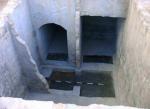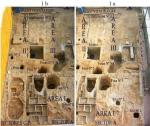Summary (English)
This 512.13 m2 site is located opposite the Eras de la Sal wharf, only a few meters away from the coast of Torrevieja. The aim of this excavation was to enhance our understanding of the environment and economic activity of the area from the modern period, without discarding the finding of the foundation of the so-called Torre Vieja.
The extensive archaeological excavation was conducted in three areas:
- Area I: This area was, in turn, subdivided into three sectors. Sector A, whose major axis is perpendicular to Patricio Pérez Street, coincides with the most topographically elevated rocky area. Sector B, adjacent to Sector A, was occupied by a small fish-salting factory and a reservoir. Sector C is an extension of Sector B and is demarcated by a masonry base made up of two octagonal floors that overly what might have been the warehouse of the fish-salting factory. – Area II: This area is partially opened to the Paseo de Vista Alegre and is adjacent to a neighbouring building, forming an inverted L-shaped angle with respect to Area I. Moreover, its major axis is parallel to Area III. – Area III: This area is parallel and contiguous to Patricio Pérez Street and is part of the Paseo de Vista Alegre.
With respect to the interpretation of the archaeological findings:
In an undetermined moment,, possibly in the 18th century, the first hamlet was established next to the “Torre Vieja”. The occupancy took place in an open space facing the sea and displayed a two-way incline: one towards the south, or the costal line (Eras de la Sal Street and Paseo de Vista Alegre), and one towards the east (Patricio Pérez Street and Orihuela Street). Both the silos found on the site and the cuts found in the base rock make it clear that a temporary settlement was established there.
If remains of a wall pertaining to this moment had existed, they would have disappeared during the 19th century. At the end of the 19th century or during the first few decades of the 20th century a clearly planned out urban environment was erected, including the construction of the fish-salting factory and other establishments. If the next interventions were to confirm the existence of the Cuartel de Carabineros, or a small fish-salting factory, it would have to be related to the control the State exercised over tuna fishing, salt lakes, and fish-salting factories, regardless of whether or not they were rented out to private parties.
(translation by Emily Marie Polacek)
- Bienvenido Mas Belén
Director
- Bienvenido Mas Belén
Team
- Museo del Mar y de la Sal de Torrevieja
Research Body
- Colegio Oficial de Doctores y Licenciados en Filosofía y Letras y en Ciencias de Alicante - Sección de Arqueología
Funding Body
- Torrevisa, S. A.






![Download [PDF]](/excavation/skins/fasti/images/results/download_sml.png)


